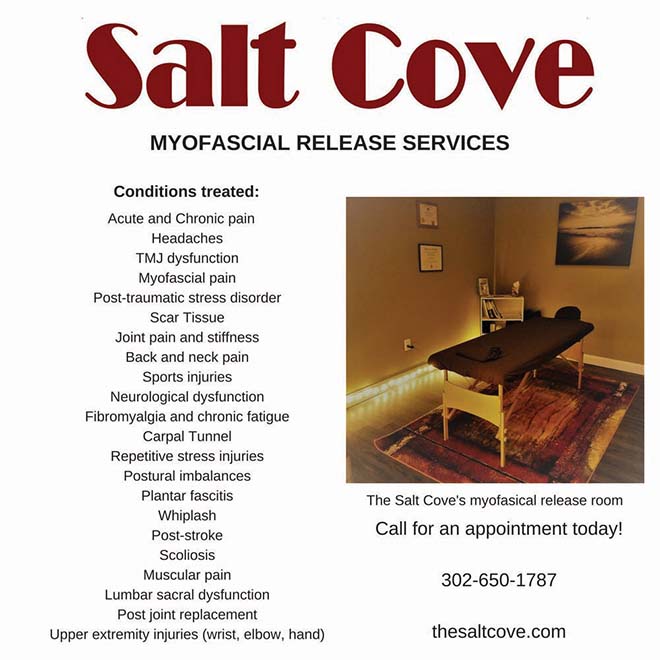Healing With Myofascial Release
 By Shannon Bushong, DPT
By Shannon Bushong, DPT
Myofascial release is a safe, holistic hands-on technique that releases fascial restrictions in the body. A therapist trained in myofascial release can add this therapeutic modality to their treatment repertoire for their patients to reduce pain and restore function.
Fascia is a three dimensional web of tough connective tissue that runs from head to toe uninterrupted. Fascia covers every muscle, bone, organ, and nerve in the body. Research has shown that the fascial system is fluid, and the main transport system in the body. The fascia also maintains the body’s normal shape and proper alignment of organs.
Poor posture, inflammation, physical and emotional trauma, scarring, surgery, and repetitive stress can all cause the fascia to restrict. These restrictions can exert tensile pressures of up to 2000 lbs. per square inch on any body part. This abnormal pressure continually binding down on areas of your body leads to pain, and dysfunction. Myofascial restrictions also cause the ground substance that surrounds the fascia to solidify, and the inability of cells to excrete toxins and waste products they need to get rid of to function normally.
Since the fascia is a continuous structure from head to toe, restrictions in one part of the body can cause pain and limited function in another. Think of a knitted sweater, if you pull on one piece of yarn, it will ultimately affect the entire sweater. This is similar to what fascial restrictions can do. Fascial restrictions go undiagnosed, as they are not evident on standard medical diagnostic tests such as XRAYS, CT scans, and MRIs.

At the Salt Cove, the John F. Barnes’ Myofascial Release approach is utilized as part of a patient’s treatment. This approach focuses on gentle hands-on low load pressure sustained in areas of fascial restrictions. The goal of the sustained pressure is to elicit a release of the underlying fascia. The sustained pressure in this approach is based off of the viscous flow, piezo-electricity phenomenon. Fascial tissue is what is known as piezo-electric tissue. What this means is that when the therapist applies gentle pressure for a period of time, whether it is compression, traction, or stretching, it results in a greater flow of the viscous medium and the body’s bio-energy. The timing of the sustained pressure is crucial in achieving lasting changes in the body’s fascial system. In order to release the deepest layers of fascia the therapist must hold the pressure for at least five minutes or longer. The initial superficial releases occur after 90 seconds to two minutes when the therapist sinks down past the collagenous barrier of the skin. Sustained pressure for at least five minutes allows for the therapist to go through barrier after barrier until the deepest layers of fascia are reached. Since fascia releases from superficial to deep, multiple treatments may be needed to achieve lasting changes in the fascial system.
Myofascial release results in a mind-body effect. Myofascial release can trigger the mind-body complex into motion, and allows a person to release emotions trapped in the fascia, as well as negative holding patterns causing tension and pain. Myofascial release allows for therapeutic motion to take place, and subsequent physical and emotional releases allow for the body to heal.
A healthcare professional trained in myofascial release will perform an evaluation where posture, structural alignment, and texture of tissue are assessed. The therapist will note any vasomotor responses on the patient’s body which will determine what areas to treat. Multiple visits are usually indicated in order to achieve lasting changes in the fascia.
Myofascial release is effective in treating a variety of conditions. These include, acute and chronic pain, headaches, TMJ, PTSD, back and neck pain, sports injuries, fibromyalgia, carpal tunnel, scars, plantar fasciitis, lumbar-sacral dysfunction to name a few. If you are unsure if myofascial release would be indicated for you, it is recommended you consult with your primary health care provider.
Shannon Bushong, DPT graduated with her Master’s in physical therapy from MCP Hahnemann University in 2001, and her doctorate from the University of Scranton in 2010. She has over 14 years of experience as a physical therapist. Dr. Bushong has been trained in seminars instructed by John F. Barnes, PT, LMT, NCTMB, the developer of the myofascial release approach. She practices myofascial release physical therapy to reduce pain and restore function in patients.

302 650 1787




